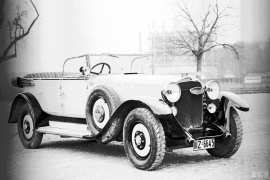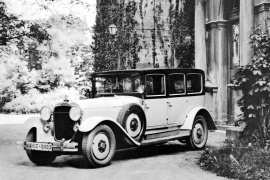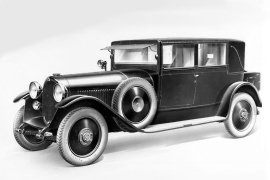
MAYBACH Typ W1, W2, W3, W5 and W5 SG
Generations Timeline, Specs and Pictures

Carrying on his father’s pioneering work, young Karl Maybach came with his first engine dubbed the W1 in 1919.
Much like an artist’s sketch, the design was used as a study for the later developed W3 concept, unveiled at the Berlin Motor Show in 1921. However, his W1 “Testwagen” is far from being forsaken, having been one of the most daring designs at the time thanks to its in-line 6-cylinder architecture couple with a Daimler sourced chassis. The engine was quite a piece of engineering, having been rated at 46 hp.

The W5 SG followed the same design patterns and technical specs as its regular stablemate with the only extra having been an overdrive transmission system.
The new gearbox led to a slight increase in power making the SG sportier and a bit more fun to drive. Luxury upholstery and accessories were of course included along a generous rear compartment with plenty of passenger room. Having had a production time of just one year, it is one of the rarest models, having been built in close to 250 units, regular and closed-body versions included.

By 1928, Maybach vehicles were very known in the luxury car segment, and the customers were concerned about their safety, so the car manufacturer offered them an option: the W5 SG.
The owners of the expensive cars were concerned. Some admired them, some envy them, and others just wanted to steal from them or kidnap them for a ransom. They needed protection, and Maybach didn’t want to make the cars even heavier. The government already required a CDL driving license due to their weight, and adding armor plating was not an option. Maybach approaches the problem differently: it built a designated area for security guards.
The W5 SG featured the same bodywork as the regular W5. At the front, the carmaker installed a sturdy bumper in front of the wheels. It mounted them directly on the chassis. The owners could have chosen an even thicker bumper that could blast through a roadblock. The vehicle’s tall radiator sat in a protected area, above the front axle with a chromed surrounding. Its front fenders were shorter than on other cars from that era. Behind the closed cabin, Maybach installed an additional bench where two security guards could sit and watch above the car’s hood.
The interior was typical for a Maybach. It provided expensive leather seats, wood trims, and a communication tube to ask the driver where to go and when to stop. The guards behind the cabin were exposed entirely, allowing them to jump and fight if needed or sit and shoot from above.
Under the hood, Maybach used the same inline-six engine as on the W5. Its seven-liter displacement received a new carburetor and higher compression ratio, raising the power to 120 hp, which was a lot for those times.

The open top body shared the same features as its closed-body sibling, with the same trade-mark styling complete with opaque steel-disc wheels that gave the car a particularly rugged look.
However, the wheel-design and solid axle suspension sturdiness was counterbalanced by an almost delicate interior, equipped with a variety of comfort-enhancing utilities, such as rear folding tables, drink holders and different storage compartments. Passenger room was well delimited through the employment of a central folding armrest while the rest of the compartment was full of handles and cushioning for a bumpless ride.

Although design was not a major concern among car manufacturer’s at the time with most models having shared the same box-like appearance, the open-body W3 has a sleek, stylish appearance.
Mostly thanks to its manually operated retractable soft-top and variety of coachwork, this model seemed much sportier than its closed-body sibling. The car’s nose had the basic rectangular shape on all versions while the rest of the body was available in multiple configurations with one or separate front/rear compartments for a racing look. Built in even fewer units than the closed-body model, it was a very rare sight back then as it is today.

Less sportier than the open-top but more majestic thanks to its whole, harmoniously designed body, the W5 was the limousine of the mid and late 20’s having arrived with a generous cabin and plenty of luxury touches.
Of course, Maybach has always been synonymous with “refinement” so reiterating the actual inner beauty of such vehicles would be simply pointless. Easily recognizable by its large cabin with 3 pairs of symmetrically cut side windows, this wheeled king’s carriage rolled on an improved chassis fitted with a 7.0 L petrol unit rated at 120 hp.

Two years after Karl Maybach finished his innovative W1 Testwagen, he delivered an updated version dubbed the W3 during the Berlin Motor Show in 1921.
based on his initial design, the car seemed a raging road-destroyer compared to other vehicles at the time, having been fitted with a an upgraded in-line 6-cylinder 5.4 L petrol engine rated at 70 hp. The engine could propel the car to a top speed of 68 mph (109 kmh) via a rear-wheel drive, setting a top-sped threshold highly uncommon at the time. Having marked Karl Maybach’s full debut into car manufacturing, the W3 was built in 305 units, having been one of the rarest models.























































